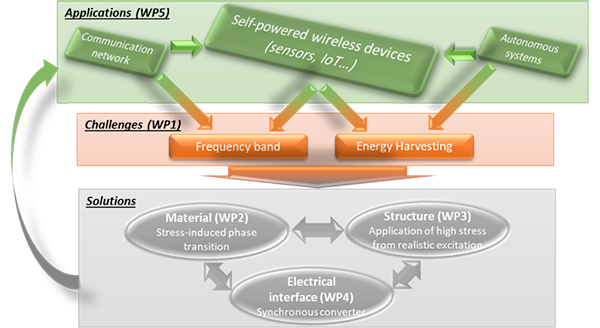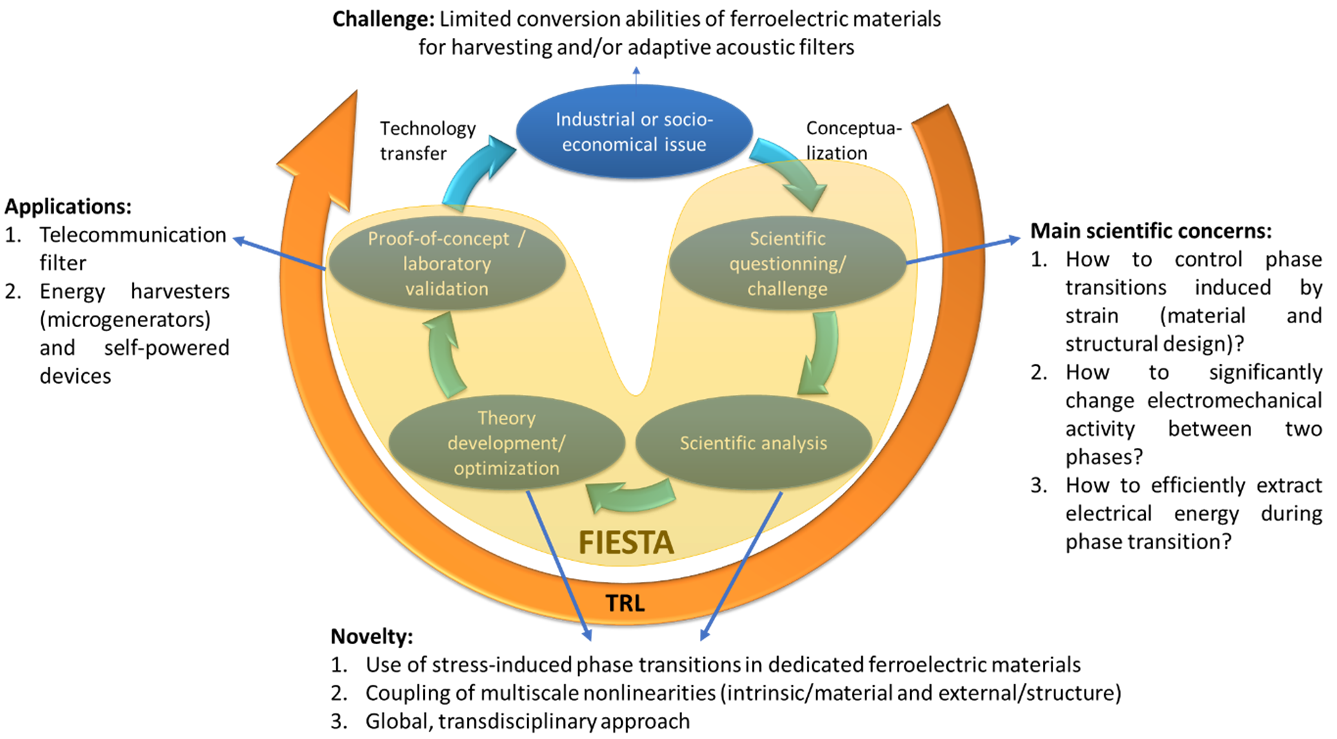
Project Description
The rise of wireless interconnected devices, for instance in the framework of the Internet of Things (“IoT”), shows unprecedented promising outcomes in the framework of the communication society (smart cities, digital society…). At the dawn of the advent of IoT and 5G, where forecasts predict more than 75 billion of connected devices worldwide by 2025 ([1]), representing between $4 trillion to $11 trillion in economic value ([2]), unique opportunities appear for instance in terms of global communication, sensing and monitoring for structural, goods and person safety (buildings, transportations…) or gathering information from numerous environments to achieve better life quality as well as sustainable development. Progresses in these fields however raise, in addition to ethical questioning, numerous technical issues (data processing…) especially, at the device level:
To address such challenges, FIESTA proposes an innovative approach using stress-induced transitions in ferroelectrics. These materials present attractive properties such as good electromechanical coupling, good power density, high integrability and easy control, as well as secondary benefits such as resilience to electromagnetic perturbation (contrary to ferromagnetic ones). While they have mostly been used considering linear behavior, FIESTA proposes to go beyond this comfort zone, taking advantage of intrinsic nonlinearities in such materials embedded in a global system to obtain acoustic filters providing frequency band hopping as well as energy harvesters with power densities beyond the state of the art (a decade is expected), both developed in parallel but sharing many common aspects (low required stress for phase transition, piezoelectric behavior in both phases, high fatigue life…). In the framework of FIESTA, the project is mainly constructed around a common material (KTN) that allows realistically reachable stress-induced transition for both applications, with extension to polymers for energy harvesting. Because of the strong link between stress and temperature at the structural level, researches and developed technologies will be also adaptable to thermal excitation. In terms of energy harvesting for instance, this enables realistic multifunctional harvesters efficiently converting energy from both mechanical and thermal sources.

FIESTA context, objective and methodology and link with scientific and technical Work Packages
Proposing new insights and devices requires merging disciplines and promoting transdisciplinarity to transcend outcomes, yielding a competence of the sum greater than the sum of competence. FIESTA embraces all aspects combining material science, physics, mechanical and electrical engineering and, last but not least, the interfaces between them. This will ultimately allow globally optimized researches and applications, while combinations of independently optimized blocks yield sub-optimal global systems due to numerous bidirectional interactions at various scales. An example in FIESTA is to optimize the material properties to ensure reachable stress-induced transitions by using elaboration methods with low cost and upscaling possibilities. What is usually considered as a limitation will therefore be taken in advantage to propose innovative solutions for the two applicative targets of the project, both sharing the unique characteristics of a single material (KTN) in the form of film or bulk shape. Furthermore, with this transdisciplinary approach multiscale nonlinearities also arise, combining intrinsic material ones with those generated from the electrical interfaces.
Nonetheless, in addition to common transversal aspects, FIESTA will also bring significant advances in each field. It is expected that material tailoring will unveil the mechanisms behind phase transitions induced by temperature and uniaxial/biaxial stress and related nonlinearities of physical properties, as well as parameters (compositions, elaboration procedure…) to control this effect. On the mechanical side, new structures generating high stress from realistic excitations will be developed.
One key philosophy behind FIESTA is also to strongly link fundamental research with societal needs while keeping a genuine scientific questioning. More particularly, the principles of the project aims at starting from the scientific conceptualization of socio-economic challenges to translate them into scientific issues, that are then thoroughly and scientifically analyzed to bring solutions to the original issue (Figure 3) thanks to the transdisciplinary approach.

Positioning and scientific approach of FIESTA.
[1] https://www.statista.com/statistics/471264/iot-number-of-connected-devi… (last viewed: 23/02/2020)
[2] https://www.mckinsey.com/business-functions/mckinsey-digital/our-insigh… (last viewed: 25/02/2020)
[3] Ruppel C C W 2017 IEEE Trans. UFFC 64 1390. https://doi.org/10.1109/TUFFC.2017.2690905
[4] Malmodin J and Lundén D 2018 Sustainability 10(9) 3027. https://doi.org/10.3390/su10093027
[5] Graver B, Zhang K and Rutherford D 2019 ICCT Working Paper 2019-16. https://theicct.org/sites/default/files/publications/ICCT_CO2-commercl-… (last viewed: 14/05/2020)
[6] https://www.marketresearchfuture.com/reports/rf-filters-market-6530 (last viewed: 23/02/2020)
[7] VanZwol J 2006 Power Electronics Technology July 2006 40–45. https://www.powerelectronics.com/ markets/mobile/article/21853567/designing-battery-packs-for-thermal-extremes (last viewed: 14/05/2020)